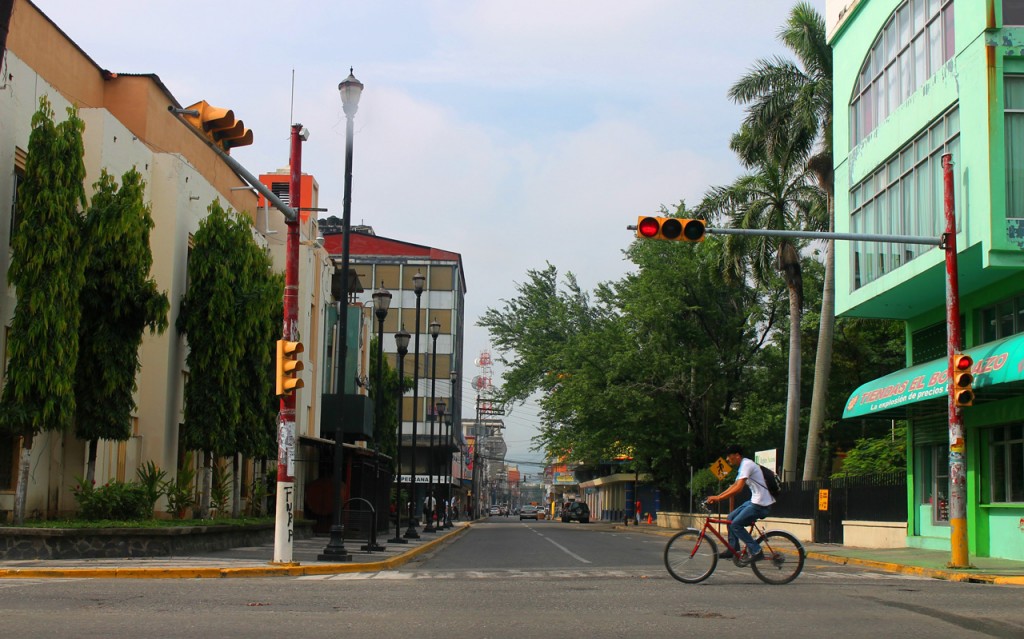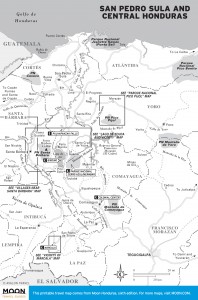
Cycling down Quinta Avenida in San Pedro Sula. Photo by Roberto Venegas licensed Creative Commons Attribution.

San Pedro Sula and Central Honduras
Situated on the southwestern edge of the broad, fertile Valle de Sula, up against the flanks of the Sierra Merendón, San Pedro Sula (often shortened to San Pedro) is a bustling, hot, modern city. If Honduras’s governmental capital is Tegucigalpa, its business and financial capital is San Pedro Sula. According to recent statistics, the 800,000 inhabitants of the city and immediate vicinity produce 40 percent of the national GDP.Unless they come to San Pedro on business, most foreign visitors stop in the city only briefly. In spite of its nearly five centuries of existence, San Pedro has virtually no remaining colonial architecture. There are two good crafts markets and one historical museum, numerous restaurants offering top-notch Honduran and international cuisine, and nightspots for every taste and budget.
If you need to take care of some errands while on the road, San Pedro is a good place to do them, as it has just about every sort of store or business you could hope to find in Honduras. The city has a grid layout with numbered streets and is very easy to get around.
A large number of expatriates make their home in the city. Those who can afford to live in the wealthier, suburb-like neighborhoods, on the west side of San Pedro at the edge of the mountains, find it a reasonably pleasant place to live.
A word of warning: Crime in San Pedro is fairly widespread. Although much of the crime is related to gang activity that the typical traveler will never come across, tourist muggings are not unheard of, so pay attention to who’s around you and where you are, especially after dark.
San Pedro is at about 40 meters elevation, and the climate is steaming hot most of the year, with daytime temperatures varying between 25 and 38°C (77–100°F). Rains in the Valle de Sula, which normally hit between July and November, can be torrential but help cool the city down.
San Pedro is the central transportation hub for northern and western Honduras and is frequently the gateway to the country for foreign visitors on their way to the north coast or Bay Islands. Most bus travelers in Honduras will eventually find themselves passing through San Pedro.
By AirAeropuerto Internacional Ramón Villeda Morales, 13 kilometers from downtown San Pedro, has a branch of BAC Bamer bank for exchanging money and three ATMs, Casa de Puros for picking up cigars, Wendy’s, Espresso Americano and DK’d Donuts, and several car rental agencies located in the international arrivals section. There are a couple of steeply overpriced gift shops. Taxis from town to the airport cost about US$10, and there’s no way to get there by bus. If you’re leaving the country on an international flight, be prepared to pay a US$34.04 departure tax (in dollars or lempiras, but change is given only in lempiras). Domestic flights are subject to a tax of US$1.50.
Several airlines offer domestic and international service from the San Pedro airport, including:
All intercity buses headed to San Pedro arrive at the relatively new bus terminal (504/2516-1616) five kilometers south of downtown on the highway that leads to Tegucigalpa. The terminal has a food court with chains like SuperJugos, Pizza Hut, and Antojitos Mexicanos; public restrooms; a health clinic and pharmacy; and a bunch of stores selling everything under the sun (in case you want to pick up a new fridge before hopping on the bus?). There is a branch of BAC Bamer, with an ATM, and a Banco Ficensa also with an ATM, where Western Union transfers can be picked up.
Smaller companies that run buses to towns around the country have windows in the terminal, while the bigger luxury lines have their own private waiting areas (note that Congolón and Cotisa lines are tucked in the same side section as Sultana). The schoolbus-style buses that go to the small towns surrounding San Pedro (known as interurbanas and rapiditos) do not have sales windows; the ticket is bought directly on the buses, which are lined up at the platforms (you have to ask around to find the one you need). There is a directory of companies and their destinations near the entrance.
Taxis to and from the bus terminal and the center of San Pedro should cost US$3.50–4. There is a taxi stand at the exit of the bus terminal—come out here to take one, and do not use the business of the guys lurking inside and offering taxi services.
King Quality (504/2516-2167) runs one bus a day to San Salvador. The bus is equipped with a bathroom, air-conditioning, and TV (whether you like it or not). The bus continues on to Guatemala city, and then on to Tapachula, Mexico. Headed the opposite direction, one bus a day departs for Managua, Nicaragua, then heads on to San José, Costa Rica.
Torito y Copanecos (504/2516-2046) also runs buses all the way to San Salvador.
Hedman Alas (504/2516-2273) has two direct first-class buses to Guatemala City via Copán Ruinas and to Antigua, Guatemala.
Tica Bus (504/2516-2022) has an office not far from the food court with daily service to Nicaragua. The same bus continues on to Costa Rica and Panama.
Congolón (504/2553-1174) has two direct buses a day to Guatemala City.
Fuente del Norte (504/9843-0507) has daily service to Río Dulce, Guatemala City, and connections on the border with Mexico and to Belize City.
By Car
As the country’s major industrial center, San Pedro Sula is well connected by paved road to the rest of the country. Highways to Santa Rosa de Copán, Nueva Ocotepeque, Copán Ruinas, Tela, La Ceiba, Yoro, and Tegucigalpa are all fairly well maintained and can be driven on safely most of the year. During the height of the rainy season, however, road conditions tend to deteriorate. In 2008 bridges on the main road to Trujillo washed out during the rains, but even if they haven’t been repaired by now, there is an easy enough alternative route along a well-maintained gravel road.
If you’re in a group and would like to hire someone to do the driving for you, Cotagohl (504/2442-1020), based out of the airport at La Ceiba, has chauffeured vans and specialized in picking up mission groups at the San Pedro airport and taking them wherever they need to go.
Thanks to the grid layout, San Pedro Sula is quite easy to get around in a rental car. Note that many intersections in the center do not have any stop signs in any direction: north–south has the right of way over those traveling east–west.
Taxis
Most taxis charge up to US$3 fo a ride within Circunvalación, more at night. Be sure to settle the price before you get in, as many taxistas will happily take advantage of unsuspecting foreigners. Those who wish to be cautious may prefer to get a radio taxi, which is more expensive, but safer.
Three reliable companies are Radio Taxi (504/2557-5808), Radio Taxis Belén (504/2509-4609 or 504/9751/8238), and Central de Taxi (504/2557-4020). Colectivo taxis charge only US$.60 for the pleasure of being crammed into a cab following a set route with four other passengers and the driver.
Buses are not particularly safe, nor is it easy to learn the routes; given that taxis are cheap, they’re generally the recommended way to move around. A taxi to the bus station is US$3.50–4, to the airport about US$10.
Excerpted from the Sixth Edition of Moon Honduras & the Bay Islands.